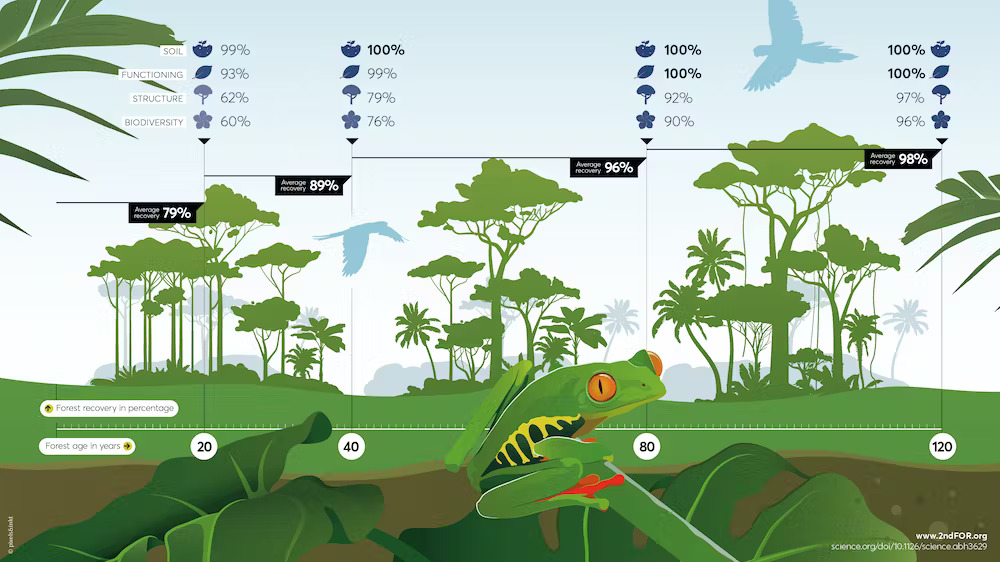Tropical Forest Restoration

Changes in soil, ecosystem functioning, forest structure and tree biodiversity as tropical rainforests restoration (The Conversation)
Tropical forest restoration is a critical solution for reversing climate change, with the potential to significantly reduce greenhouse gas emissions and enhance carbon sequestration. This article outlines the progress, challenges, and future directions of tropical forest restoration efforts worldwide, with a focus on innovative companies and technologies in this space.
Overview
In the past decade, there has been increasing interest in tropical forest restoration as a means to reduce greenhouse gas emissions and help reverse climate change. Breakthrough technologies such as satellite mapping, remote sensing, and AI-driven analytics have made it possible to more accurately assess the extent of forest degradation and deforestation, as well as identify potential areas for restoration.
Progress Made
Significant advancements have been made in tropical forest restoration technologies:
- Remote Sensing and Mapping: High-resolution satellite imagery and LiDAR technology for precise forest mapping.
- AI and Machine Learning: Predictive models for optimal planting strategies and monitoring forest health.
Solutions by Sector
Remote Sensing and Mapping
- Satellite Imagery: High-resolution forest cover analysis and change detection.
- LiDAR Technology: 3D mapping of forest structure and biomass estimation.
- Hyperspectral Imaging: Detailed analysis of forest health and biodiversity.
Case Studies:
- Planet Labs, USA: Provides daily satellite imagery for monitoring deforestation and restoration progress (Planet).
- Pachama, USA: Uses AI and satellite imagery to verify and monitor carbon capture in reforestation projects (Pachama).
- Orbital Insight, USA: Applies AI to geospatial data for tracking land use changes and forest cover (Orbital Insight).
Drone-based Reforestation
- Seed-planting Drones: Automated aerial seeding for large-scale reforestation.
- Monitoring Drones: High-resolution imagery for tracking restoration progress.
- Precision Forestry: Targeted interventions using drone-collected data.
Case Studies:
- DroneSeed, USA: Uses drone swarms for precision tree planting and restoration monitoring (DroneSeed).
- Dendra Systems, UK: Combines AI, drones, and ecology for landscape restoration (Dendra Systems).
- BioCarbon Engineering, UK: Develops drone and AI technologies for ecosystem restoration (BioCarbon Engineering).
AI and Data Analytics
- Predictive Modeling: AI-driven analysis for optimal planting strategies.
- Forest Health Monitoring: Machine learning algorithms for early detection of forest threats.
- Carbon Sequestration Estimation: AI-powered tools for accurate carbon accounting.
Case Studies:
- SilviaTerra, USA: Uses AI and satellite imagery to provide forest inventory and carbon data (SilviaTerra).
- 20tree.ai, Netherlands: Applies AI to satellite imagery for forest monitoring and management (20tree.ai).
- Restor, Switzerland: Develops an AI-powered platform for global ecosystem restoration (Restor).
Challenges Ahead
- Scale: Expanding restoration efforts to meet global targets.
- Funding: Securing long-term financial support for restoration projects.
- Technology Adoption: Encouraging widespread use of innovative restoration technologies.
- Local Engagement: Ensuring community involvement and benefit-sharing in restoration projects.
Best Path Forward
- Investment in R&D: Continue developing and refining restoration technologies.
- Public-Private Partnerships: Foster collaboration between tech companies, governments, and NGOs.
- Capacity Building: Train local communities in the use of restoration technologies.
- Policy Support: Implement policies that incentivize the use of innovative restoration approaches.
- Monitoring and Verification: Establish robust systems for tracking restoration progress and impacts.
Tropical forest restoration presents a significant opportunity for climate tech innovation. By leveraging cutting-edge technologies and fostering collaboration between various stakeholders, we can accelerate the pace and scale of forest restoration efforts worldwide.
Image credit: Changes in soil, ecosystem functioning, forest structure and tree biodiversity as tropical rainforests restoration (The Conversation)